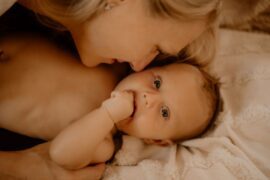ATTACHMENT
As important as restorative, health-promoting sleep is to establishing well-being, bonding and attachment issues remain paramount in babies. Without bonding, babies fail to thrive (Fisher et al 1997) or even risk death (Spitz 1946). Attachment is a biological necessity that stems from the reliance of immature infants upon their caregivers for protection, advantage and basic survival (Bowlby 1982). The necessary protection is achieved via attachment relationships and consequently the degree to which we are excellent caregivers governs the degree to which our offspring reach optimal development (Perry 2001). Attachment security in infancy is associated with healthy mutually satisfying relationships, optimal cognitive functioning and emotional and behavioural management later in life (Karen 1994). Secure attachment relationships are marked by a mutual bond in which the mother, or other caregiver, shapes infant development through her interactions and relationship with her child (Bowlby1982). These relationships then allow for the formation of an ‘internal working model’ that functions as a template by which babies can gauge their own emotions and those of others (Marvin & Britner 1999). The hallmarks of attachment security are availability, responsiveness and sensitivity (Ainsworth 1973).Hence it is not just the presence of the parent, but the quality of the parental response, their emotional availability and their sensitivity to the baby’s communication that form the heart of a child’s security (Kobak 1999). When a baby is cared for in this wholly sensitive way, a secure relationship will likely develop and form a foundation for emotional health that lasts a lifetime. It is critical that infant sleep is approached with sensitivity to attachment needs and afforded high levels of attunement and responsiveness. All aspects of development are influenced by fundamental attachment relationships. For example, the human brain adds 70% of its structure after birth (Schore 2001). Hence our genetic potential is expressed via our experiences (Siegel & Hartzell 2004). Positive, nurturing parental response impacts the brain in two very important ways: it decreases the impact of subsequent stress on the brain (Cozolino 2006) and it enhances brain growth and the development of brain systems that support attachment, emotional regulation and problem solving (Davidson2000). Babies who experience soothing touch, comforting warmth, repeated experiences of calming when distressed, a sustained positive emotional state and homeostatic balance when tired, hungry or over stimulated grow to develop healthy emotional regulation, brain growth and self esteem (Cozolino 2006). On the other hand, babies who experience neglect or abuse during their early life are at risk for mental illness, behavioural disturbances, cognitive impairment, and brain damage (McEwen 2000; Perryet al 1995). Because infancy is dedicated to an explosion in brain growth and neural connectivity, those years are widely considered the most critical period of development (Perry et al 1995). These are also the years that overlap with the most inconsistent sleeping patterns in babies.
SLEEP TRAINING
Consistent with our cultural preferences for independent sleep, itis common for parents and professionals to have concerns about infant sleep patterns along with an accompanying desire to create longer, more stable night time sleep routines. The use of sleep techniques, such as controlled crying, is often recommended. These methods employ strategies in which a baby is left to cry for increasingly longer intervals until s/he learns to go to sleep independently. Depending on the authors, this strategy can be employed anywhere from birth through the first year of life (Ferber 1986; Hall 2006; Hogg & Blau 2002). However, sleep training overlooks a baby’s psychological and physiological well being. Rather, it addresses a baby’s behavioural repertoire and utilizes interventions to affect change. When these approaches work – and their success is mixed and often unsustained (Middlemiss 2004) – they do so purely on a behavioural level and often at the expense of optimal emotional well-being (Gethin & Macgregor 2007). Similarly, approaches that emphasize independent, solitary sleep and discourage responsiveness to separation protests contradict our knowledge that mother-infant separation produces severe physiologic responses (Hofer, 2005).
Sleep training methods pose serious risks to infants. When babies are in close proximity to their mothers and when their needs are responded to with attuned sensitivity, babies remain regulated (Schore 2001). Babies are not born with an ability to independently regulate their physiological or emotional states but rely, instead, upon a caregiver to do this with and for them (Siegel 2001). We are all familiar with the need to place a newborn on their mother’s chest to assist the baby with maintaining body temperature, due to the newborn’s inability to regulate body temperature without assistance. Other aspects of regulation, such as heart rate, cortisol levels and digestion, are also regulated within the context of this relationship (Hofer 1996). These ‘hidden regulators’ are the physiological mechanisms that keep babies in homeostasis and form the foundation of future regulation (Hofer 1996).
Emotional regulation is the same. Babies need assistance in managing their emotions so they do not become overwhelmed. Whether its fear, sadness, surprise or excitement, babies can quickly succumb to emotional intensity. They are especially vulnerable to fear as they possess vast amounts of neural circuitry to analyse this emotion but few that assist them in feeling good (Cozolino 2006). Thus it is critical that babies be assisted in maintaining emotional balance and helped to return to a regulated state when out of balance. When they are dysregulated, babies are vulnerable to the deleterious effects of stress (Schore 2003).










